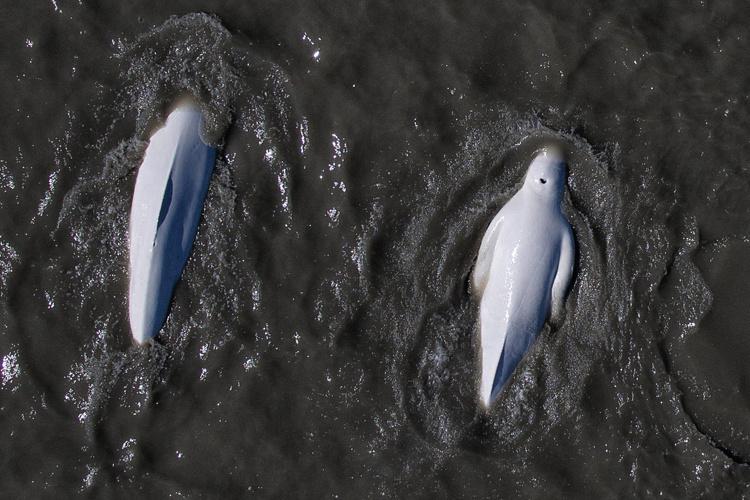We are back in Anchorage for Leg 2 of our study, during another series of low tides. Getting a new field project going can be a lot of work, so I was too busy to report in real time during Leg 1 (Aug. 3-7), but I can provide a summary now, and let’s just say it was a bit too good to be true (some of the locals said we caught a few of the best days of the summer).
We were able to go out every day. We found whales every day, and we were able to fly every day. We started out with a bang, as Hollis and Jake were able to make 7 flights the first day, followed by 7, 9, 1, and a record setting 12 flights the last day.
So our five-day total was 36 flights, ~6 hours of flight time, and 8,772 photographs taken by the hexacopter!
It was fairly overcast the first day. But, after that we had lots of sun and clear skies. On one day, we even had great views of Denali, which is about 140 miles north of Cook Inlet.
It Takes Two
The flight team is truly a two-person team—one person flies the hexacopter while looking at it, and the second person looks at the real-time video feed to see what the hexcopter is over, and triggers the camera to take still photographs when over whales. They have to talk to each other constantly so the pilot can move the hexacopter to where the whales are, depending on what the camera person is seeing.
The close quarters on a small boat make the hexacopter operations a little tricky, but Hollis and Jake make it look easy. After some initial powering up and testing, and a check of the camera settings, they get ready to go. They launch the hexacopter from the bow of the boat—the camera operator holds the aircraft overhead, and the pilot flies it out of the camera operator’s hands. Then the camera operator sits down and puts a towel over his/her head to see the screen better, and starts calling out what’s on the screen to the pilot. The two swap roles every flight, because the pilot job can be fatiguing.
We have a card viewer for looking at the photos right after each flight to check for proper exposure—shooting gray and white whales against the gray water background of Cook Inlet can be a bit of a challenge, and we have to watch for overexposure of the white whales when it is sunny (a good problem to have).
My job is to communicate with the boat driver (Tom or Justin on Leg 1) to have them keep up with the hexacopter but not get too close to the whales, to scan and listen for low flying aircraft, and then when the hexacopter is over whales, to also take identification photos from the boat. We compare the new boat photographs and the aerial hexacopter photos to try to find a match in the Cook Inlet Beluga Whale Photo-ID. That way we can link our length measurements (and age class estimate) with the long-term sightings histories we have for many individuals. This helps us learn more about how animals are doing over time.
Back on Shore in the Evening
It was really exciting to get a first look at the hexacopter photos back on land during the first few days of the survey. Even though we thought we would be able to capture photographs of whales with the blowhole and dorsal ridge exposed at the same time (essential for our measurements), until we saw the photos, there was always still some lingering doubt.
But the proof was in the photographs – we don’t have an exact count yet as we have been too busy, but it is clear we already have hundreds of photographs that look suitable for photogrammetry measurements. After 11 months of planning and a lot of logistical difficulties, it felt pretty good to see all those great photographs.
Highlights of Leg 1: capturing nine whales in one frame, and capturing several mom/calf pairs.
It has been a great success so far, so much so that I am starting to worry about how long it will take to process all these photos (again, a good problem to have).
Now that you are all up to speed. Follow along by reading our daily blog for Leg 2.
Meet the Blogger
Paul Wade is a Research Fisheries Biologist at NOAA Fisheries’ Alaska Fisheries Science Center’s Marine Mammal Laboratory and project lead.
Paul joined the Lab’s Cetacean Assessment and Ecology Program in 1996, after completing a Ph.D. at Scripps Institution of Oceanography, and a NRC Postdoctoral Fellowship at the Southwest Fisheries Science Center. He has conducted killer whale research in the Aleutian Islands since 2001, and recently took over as head of Cook Inlet Beluga Whale research for the Lab.
Photographs are taken under MMPA Permit #20465. This study is a collaboration between NOAA Fisheries Alaska Fisheries Science Center’s Marine Mammal Laboratory, the Cetacean Health and Life History Program at NOAA Fisheries’ Southwest Fisheries Science Center, and the Alaska Department of Fish and Game (ADF&G).










